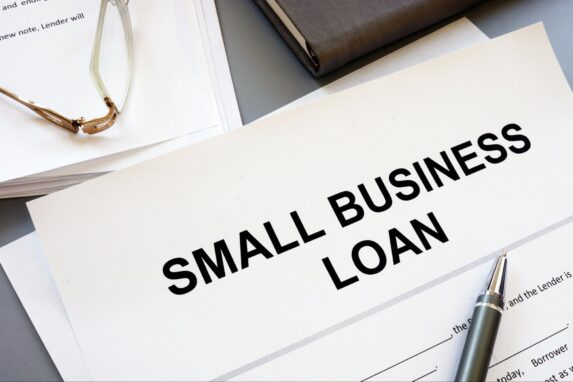How To Get A Small Business Loan In 6 Easy Steps?
Posted on: April 21, 2022 | Category: Small Business Loans

A vast variety of contemporary and traditional lenders offer small business loans. These loans can be used to help a company expand, fund new research and development, expand into new markets, improve sales and marketing activities, hire new employees, and much more.
As a small business owner, you’re certainly aware that getting finance and funding is one of the most difficult hurdles to overcome. While there are a lot of factors that go into receiving a small business loan, there are a few things you can do to make it a bit easier and enhance your chances of getting one.
While the reasons for small business loans are generally favorable, navigating the process, understanding financing choices, and meeting lending standards can be difficult. Here is a breakdown of the complicated process to get small business loans into easy understandable steps, which can help put things into focus. Furthermore, knowing the proper steps can assist you in obtaining the ideal loan for your small business needs.
6 Steps To Get a Small Business Loan:
Are you struggling to know the exact process to get a business loan? Indeed, obtaining a loan for small business entails much more than simply requesting a lender for funds. It involves understanding the repayment terms, implications, procedures, and down payment, among other things.

1. Assess Why You Need a Loan?
The very first step in getting a loan for a small business is to determine why you require one. Any lender’s first worry will be this. Also, deciding why you’re looking for a loan can have an impact on the type of loan you get. There are a variety of reasons why a small business owner might desire to take out a loan. Some are wanting to make a major investment and purchase an entire company, while others simply require additional funds to purchase equipment.
Obviously, a small business owner may want a loan for a variety of reasons. The loan may be to start a new business even when you have a bad credit or expand an existing one. Furthermore, you may need working capital loans or when you have negative cash flow only to go for small business financing.
2. Calculate How Much Amount You Can Afford?
You may not always be able to afford the loan amount you require. Calculate a loan amount for your small business that is reasonable. You can find yourself in a lot of debt if you take out too much money. If you take out too little money, you’ll miss out on the business opportunity that the loan was supposed to support. A loan calculator or a debt service coverage ratio are two tools you can use to figure out how much money you need for your small business.

A business loan calculator can help to figure out how much you’ll have to pay each month on the loan you’re asking for. To determine this, you need to provide information like your credit scores, cash flow, loan amount, and loan term. Whereas, the ratio of cash available to loan payment commitments is known as the debt service coverage ratio. Divide your annual net operating income by your annual debt payments to arrive at this figure. If the number is more than one, you have enough money to cover your loan instalments. If it’s less than one, you’ll either require more money or a smaller repayment amount.
3. Understand The Different Types Of Small Business Loans Before Choosing One:
Term Loans:
The loan amount is given upfront in these types of loans. Furthermore, the repayment must be made in fixed amounts, plus interest, over a predetermined time period. If you want to develop an existing firm and have good credit, term loans are the ideal option.
Small Business Administration (SBA) Loan:
Many banks and lenders offer SBA loans. The repayment periods for these loans depend on how the funds will be used. Furthermore, the SBA is the greatest alternative for small businesses who want to expand or refinance debt.
Business Lines of Credit:
This is a form of loan that allows you to borrow money up to your credit limit. You can repay this loan in installments. However, you only pay interest on the money you’ve taken out. If your business needs are short-term, a business line of credit with small business credit cards are an excellent alternative.
Personal Loans:
These loans are ideal for small businesses that have no credit history but have the business owner has an excellent personal credit score. You can pay back the loans in installments, plus interest, over a predetermined time period. The interest rate is fixed. Furthermore, these types of loans are unsecured loans such as business credit cards. Thus you do not need to worry about losing any personal assets.
Merchant Cash Advances:
Cash is offered up front in this type of loan. Make payments on a merchant cash advance by withholding a part of your credit and debit sales or simply withdrawing funds from your bank account. If your business can withstand regular payments, a merchant cash advance is a good option.
Equipment loans:
This form of loan is intended to assist small business owners in purchasing equipment and other alike business assets. The equipment’s value governs the repayment rates. If you want to buy rather than lease a piece of equipment, this is the best alternative.
4. Determine Your Eligibility:
Make sure you qualify for a loan before you start the small business loan application process. Examine the following aspects to evaluate your eligibility:
Credit Score:
Lenders will ask for a personal credit score from a credit reporting agency as well as a business credit score in some situations. The former reflects your repayment capacity, while the latter suggests your likelihood of repaying lenders. Your chances of securing a loan improve if you get good grades in both.
How old is the business?:
The business must be operational for at least two years to qualify to get a business loan. A minimum of one year is usually necessary when dealing with online lenders.
Annual turnover:
Many small business lenders impose a minimum yearly revenue requirement as a protection to ensure that you can repay the loan.
Repayment Capacity:
Calculate how much you can commit to loan payments by weighing your business’s cash flow and revenue against rent, and payroll. This also includes you to cover expenses which you may call as unexpected expenses.
Collateral:
Many lenders will need you to put up collateral or personal guarantee. Even if you don’t need collateral, putting one up as a personal guarantee can help you secure a bigger loan with a cheaper interest rate.
5. Compare Different Business Lenders:
It’s critical to browse around for loans for small businesses and online lenders while looking for competitive interest rates or choosing between several types of capital loans. If your small business is still comparatively new, you need cash urgently, or you don’t have any security, borrowing from online lenders is a viable solution. This is also frequently the quickest option to obtain a loan.
Micro-lenders offer the best loans if a small business is short on numbers either financially or with regards to workforce. Banks and credit bureaus offer easy loans if a small business is in operation for more than two years and their credit report is in good shape. Moreover, you can certainly obtain a favorable rate as well. However, obtaining a loan for small business from a bank or a financial institution can take from around two to six months.
Shortlist a few of the lenders and compare each of them with their pros and cons. The annual percentage rate, or the amount of interest you’ll pay over the course of a year, is the most important part of the loan to keep in mind. Consider the annual percentage rate even for short term loans or a working capital loan.
6. Documentation & Application:

Gather and prepare all financial documentation about yourself and the business, depending on the lender and type of loan. These may include tax returns, credit reports, business bank statements, personal financial statements, balance sheets, legal documents and other business plan documents. Also, prepare yourself to answer questions related to these as the lender examines them. If possible, have an accountant review your financial statements and personal credit history to identify potential concern areas. Fill in the loan application form for small business, once you have finalized the lender and type of loan you want to go for.
Conclusion:
Obtaining a small business loan appears to be exceedingly difficult, given the amount of research and analysis required. However, if you are aware of the steps on how to get a business loan, you may gain the conviction you need to present your case and get the right loan.
FAQs:
1) Are small-business loans hard to get?
Without a strong personal credit score and consistent cash flow from your business, getting a loan can be tricky. You may find these as a few of the most typical causes for your business loan application not being accepted.
2) What is the easiest loan for SBA to get?
The Hybridge SBA loan is the easiest loan to get.
3) How long is a typical small business loan?
The loan tenure entirely depends upon the type of loan and the loan terms.
SBA loan: 5-25 years
Bank loan: 3-10 years
Online loan: 1-5 years
Equipment financing: 2-10 years







